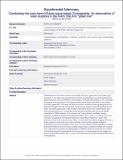Constraining the pass-band of future space-based coronagraphs for observations of solar eruptions in the FeXIV 530.3 nm “green line”
Abstract
Observations of the solar corona in the FeXIV 530.3 nm “green line” have been very important in the past, and are planned for future coronagraphs on-board forthcoming space missions such as PROBA-3 and Aditya. For these instruments, a very important parameter to be optimized is the spectral width of the band-pass filter to be centred over the “green line”. Focusing on solar eruptions, motions occurring along the line of sight will Doppler shift the line profiles producing an emission that will partially fall out of the narrower pass-band, while broader pass-band will provide observations with reduced spectral purity. To address these issues, we performed numerical (MHD) simulation of CME emission in the “green line” and produced synthetic images assuming 4 different widths of the pass-band (Δλ = 20 Å, 10 Å, 5 Å, and 2 Å). It turns out that, as expected, during solar eruptions a significant fraction of “green line” emission will be lost using narrower filters; on the other hand these images will have a higher spectral purity and will contain emission coming from parcels of plasma expanding only along the plane of the sky. This will provide a better definition of single filamentary features and will help isolating single slices of plasma through the eruption, thus reducing the problem of superposition of different features along the line of sight and helping physical interpretation of limb events. For these reasons, we suggest to use narrower band passes (Δλ ≤ 2 Å) for the observations of solar eruptions with future coronagraphs.
Citation
Bemporad , A , Pagano , P , Giordano , S & Fineschi , S 2017 , ' Constraining the pass-band of future space-based coronagraphs for observations of solar eruptions in the FeXIV 530.3 nm “green line” ' , Experimental Astronomy , vol. 44 , no. 1 , pp. 83-96 . https://doi.org/10.1007/s10686-017-9545-2
Publication
Experimental Astronomy
Status
Peer reviewed
ISSN
0922-6435Type
Journal article
Description
This research has received funding from the European Research Council (ERC) under the European Union’s Horizon 2020 research and innovation programme (grant agreement No 647214) and from the UK Science and Technology Facilities Council.Collections
Items in the St Andrews Research Repository are protected by copyright, with all rights reserved, unless otherwise indicated.

